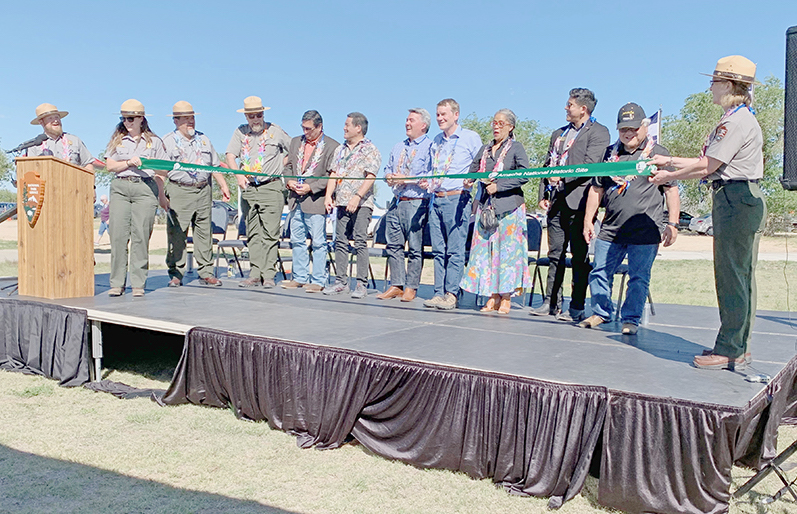
Ribbon-cutting ceremony (Photos: Rob Buscher)
In addition to a ceremony to welcome the nation’s newest
national park site, the pilgrimage offers a cross-community spiritual experience.
By Rob Buscher, P.C. Contributor
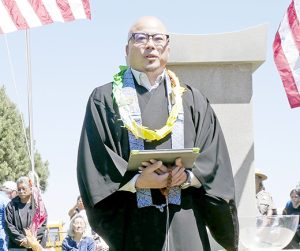
Rev. Nari Hayashi, head minister of the Tri-State Denver Buddhist Temple, speaks at Amache.
On May 17, 2024, I had the opportunity to attend the ribbon-cutting ceremony for our nation’s newest national park site, the former Amache incarceration camp, which housed more than 10,000 inmates between 1942-45. This took place during the annual Amache pilgrimage, attended by over 350 pilgrims. Located in the far outskirts of Eastern Colorado near the border of Kansas, the most direct route to Amache is to fly into Denver and drive three hours of prairie desert roads.
Arriving at the Amache Museum in Granada, I was immediately struck by how prominent the museum stood in a downtown corridor of only three or four businesses.
Like many Japanese American interpretive centers and regional museums, the collection tells a specific aspect of the wartime incarceration that centers on the unique experiences of the Amache incarcerees.
Colorado Gov. Ralph Carr was the only Western governor who welcomed Japanese American resettlers to his state during the so-called “voluntary evacuation.” Perhaps for this reason, the relationship between local residents of Granada and the incarcerees seemed to have been more positive than most other camps.
Granadans would visit Amache to watch movies at the recreation barracks, and by 1943, incarcerees were free to roam into the town. Stories like these offer a compelling alternative to the anti-Japanese prejudice and bigotry that existed elsewhere throughout the country at that time. Following a morning of volunteer tasks with the pilgrimage committee, I had my first opportunity to experience the Amache site. My first stop was the cemetery, where I visited the graves and memorial marker dedicated to the 31 Nisei soldiers from Amache who gave their lives as members of the 442nd RCT. An otherwise still day, I felt a sudden gust of wind as I approached the cemetery, which thrust the strands of origami cranes hanging from the perimeter fence into motion. I took a moment to pray a few chants of the nembutsu as I paid respects at each grave marker.
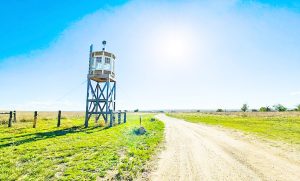
Guard tower at Amache
The next stop on my tour was the guard tower, one of eight original guard towers that once dotted the perimeter fence line. Compared to others I had seen, this was a unique octagonal shape, surrounded by some original fencing replete with barbed wire. The thought of armed guards peering out these windows with a spotlight sent shivers down my spine. Looking up from the base of the tower, this intimidating structure still looms heavy on the horizon.
I then walked toward the nearby residential barracks, a refurbished original structure that was moved back to the site after decades spent as a storage shed by some nearby rancher. In the fields of yellowing prairie grass, I spotted a small orange flower growing out of the dusty plain. Like the Amache Rose, I wondered if this had been transplanted by incarcerees from the banks of the Arkansas River, evidence of the once-vibrant garden culture at Amache. Notably, both this flower and the Amache Rose bloom only during the pilgrimage.
From there, I went to the ribbon-cutting ceremony that took place on a stage near the park entrance and honor roll. There was a crowd of about 200 Japanese Americans, local residents of Granada, tribal government leaders, Colorado elected officials and journalists.
The program began with a heartfelt tribute from John Tonai, whose late father, Min Tonai, was one of the survivors who spent decades advocating for Amache to be designated as a National Historic Site. Colorado elected officials spoke about the role that Amache NHS will play in ensuring that future generations learn from the mistakes of our past. Of particular note was the speech given by Gov. Reggie Wasano of the Cheyenne and Arapaho Tribes, who drove in from Oklahoma just for the ceremony.
Wasano commented that the United States does not want to remember history that reflects poorly on its past and that we must not take for granted the opportunity that the Amache designation provides in looking at the past with eyes wide open.
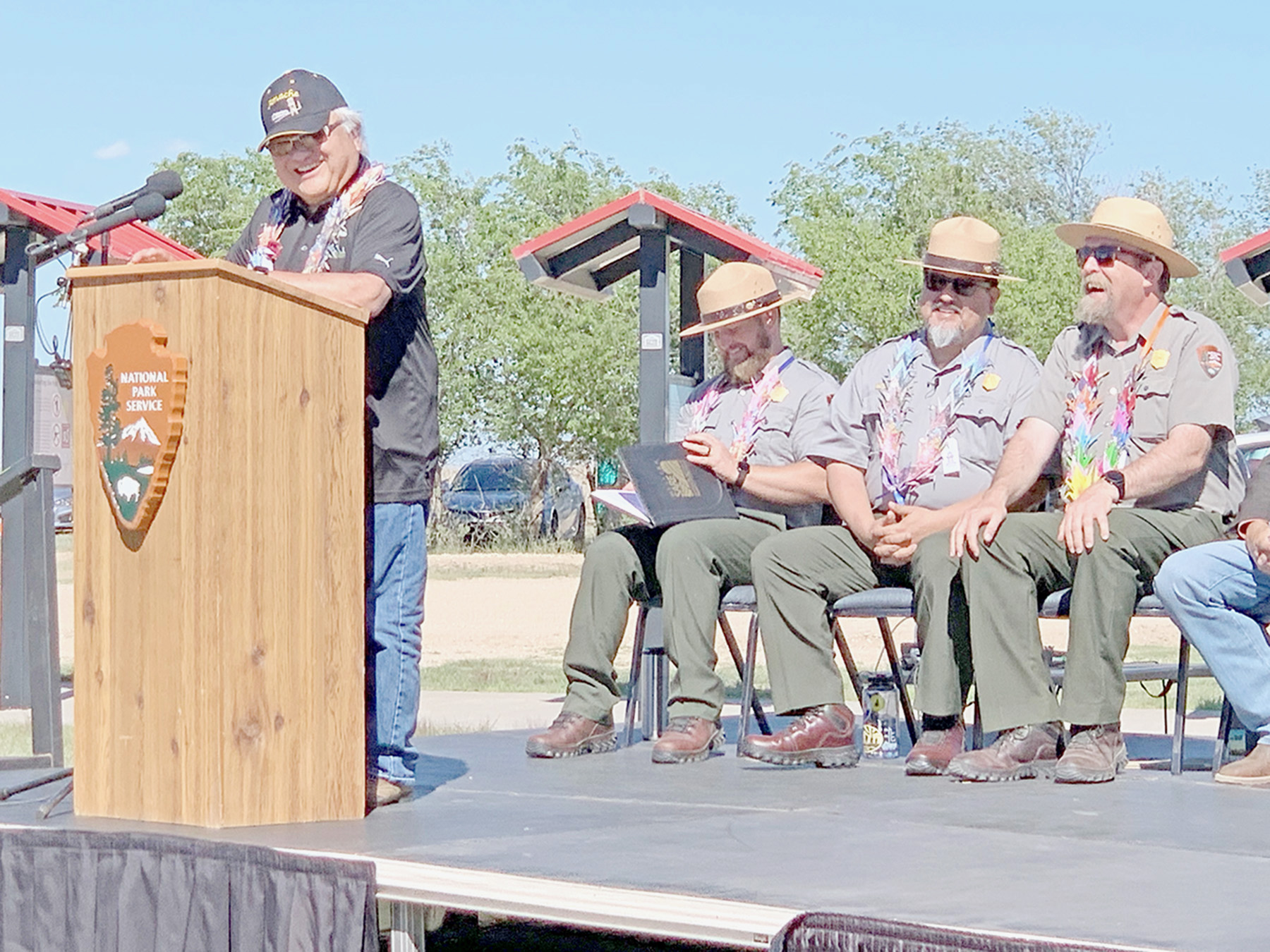
Former California Representative and Amache survivor Mike Honda addresses the crowd.
Former Congressman Mike Honda, himself an Amache survivor, also gave remarks about how significant this designation is for all Americans. Honda also thanked Wasano for his tribes’ friendship and support. The final speaker was National Park Service Director Chuck Sams, the first Native American to hold this role.
Following the ribbon-cutting, I revisited the cemetery as part of a group tour where I learned about the decades-long effort to memorialize those who died in captivity. WRA records recorded only 106 deaths at Amache, but the actual total is estimated to be closer to 200. So many babies were stillborn that they stopped counting them.
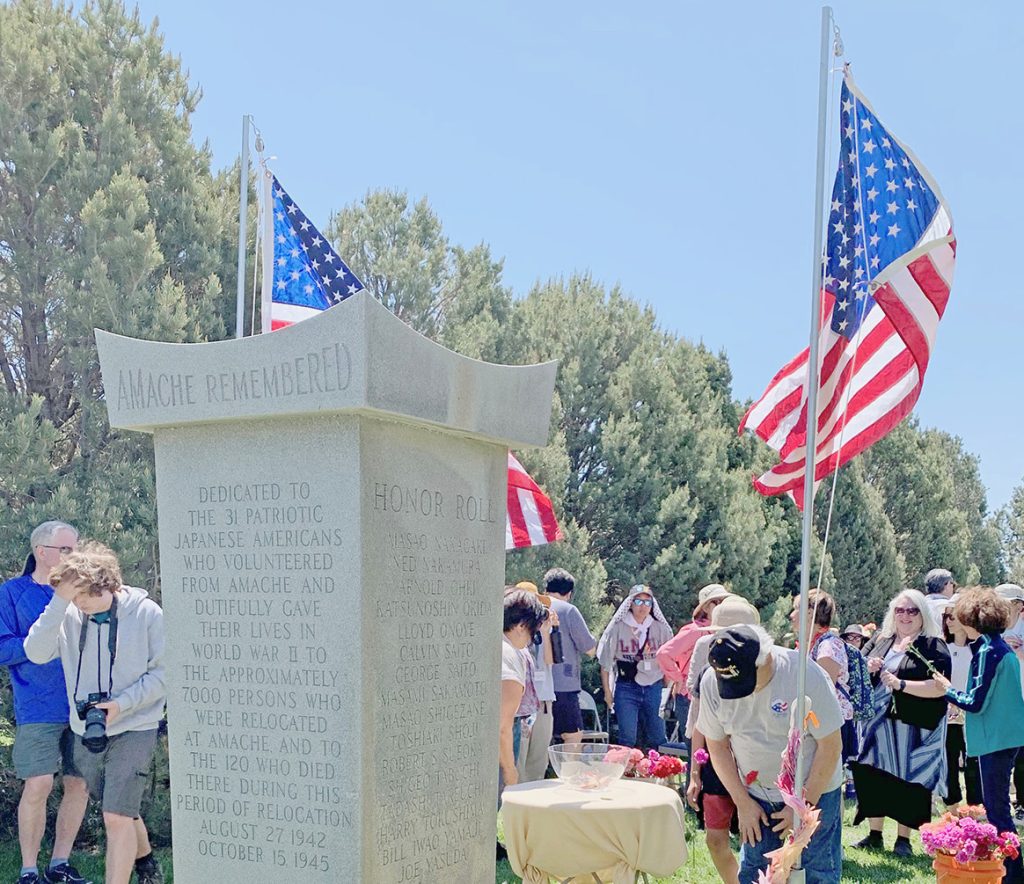 I also learned about the history of vandalism to the cemetery site, dating back to when the camp was first closed, and the cemetery memorial was desecrated by rifle blasts. Later, wooden planks with names of the deceased were burnt by arsonists. As recent as 1983 when the Nisei veterans’ memorial was installed, someone used it as target practice with a visible rifle shot just inches below the “Honor Roll” title on the monument.
I also learned about the history of vandalism to the cemetery site, dating back to when the camp was first closed, and the cemetery memorial was desecrated by rifle blasts. Later, wooden planks with names of the deceased were burnt by arsonists. As recent as 1983 when the Nisei veterans’ memorial was installed, someone used it as target practice with a visible rifle shot just inches below the “Honor Roll” title on the monument.
Amache Alliance board member Derek Okubo further elaborated on this history at Granada High School that evening. In 1982, Nisei members of the Denver Optimists Club were shouted out of a meeting with the Granada Town Council when they first expressed their intentions to memorialize the camp.
Opposition remained until Granada High School social studies teacher John Hopper started the Amache Preservation Society in 1994. The society consists of local high school students who over the past 30 years have worked with Amache survivors and descendants to renovate the cemetery, establish the Amache Museum and restore key Amache landmarks including the water tower, guard tower and barracks.
As subsequent generations of students came through Hopper’s program, they shared the harsh realities of camp life with their families, friends and extended community. Gradually, bigotry dissipated among the local residents of Granada as they began to see Amache as a significant part of their own local history. These shifting dynamics enabled the Amache site to thrive through meaningful partnerships across several organizations representing both local residents of Granada, the Japanese American community and now the NPS.
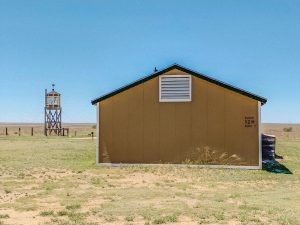
Restored residential barracks and guard tower
The next day began with a memorial ceremony that took place at the cemetery. Our already significant crowd was bolstered by a coach bus organized by the Denver Nikkeijin Kai. As the hundreds of pilgrims looked on, services were conducted by both a Buddhist monk and Christian pastor. I was struck by how the still air was suddenly broken by a large gust of wind as the Buddhist monk began chanting. Attendees were then invited to individually pay their respects by placing flowers or origami cranes at the base of the monument.
From there, the pilgrimage moved to Granada High School, where attendees enjoyed a barbecue lunch prepared by a local rancher, supplemented with Japanese American potluck dishes. Following lunch, I attended a family barracks tour with Amache Alliance President Mitch Homma. Three generations of the Homma family were incarcerated at Amache, and he brought us to visit the site of his family’s barracks.
Amache’s barracks were all built on concrete foundations that are still visible on the site. Using WRA records, and with help from Denver University, Amache Alliance has created an interactive online map that allows users to find each barracks location by searching family names. With the added benefit of the concrete foundations as visual reference points, visitors to Amache can easily find the exact site where their family lived in camp. While touring the grounds, we happened upon another Amache descendant whose family also resided in the same block.
We ended the day with dinner at the old Newman Drug store, where incarcerees used to shop for essentials they could not find at the Amache co-op. Newman would custom order specialty goods that were otherwise unavailable through the mail order catalogs that serviced the camps. Dinner was catered by Shorty’s Cafe, the only restaurant in town, which served a homestyle assortment of Tex-Mex dishes.
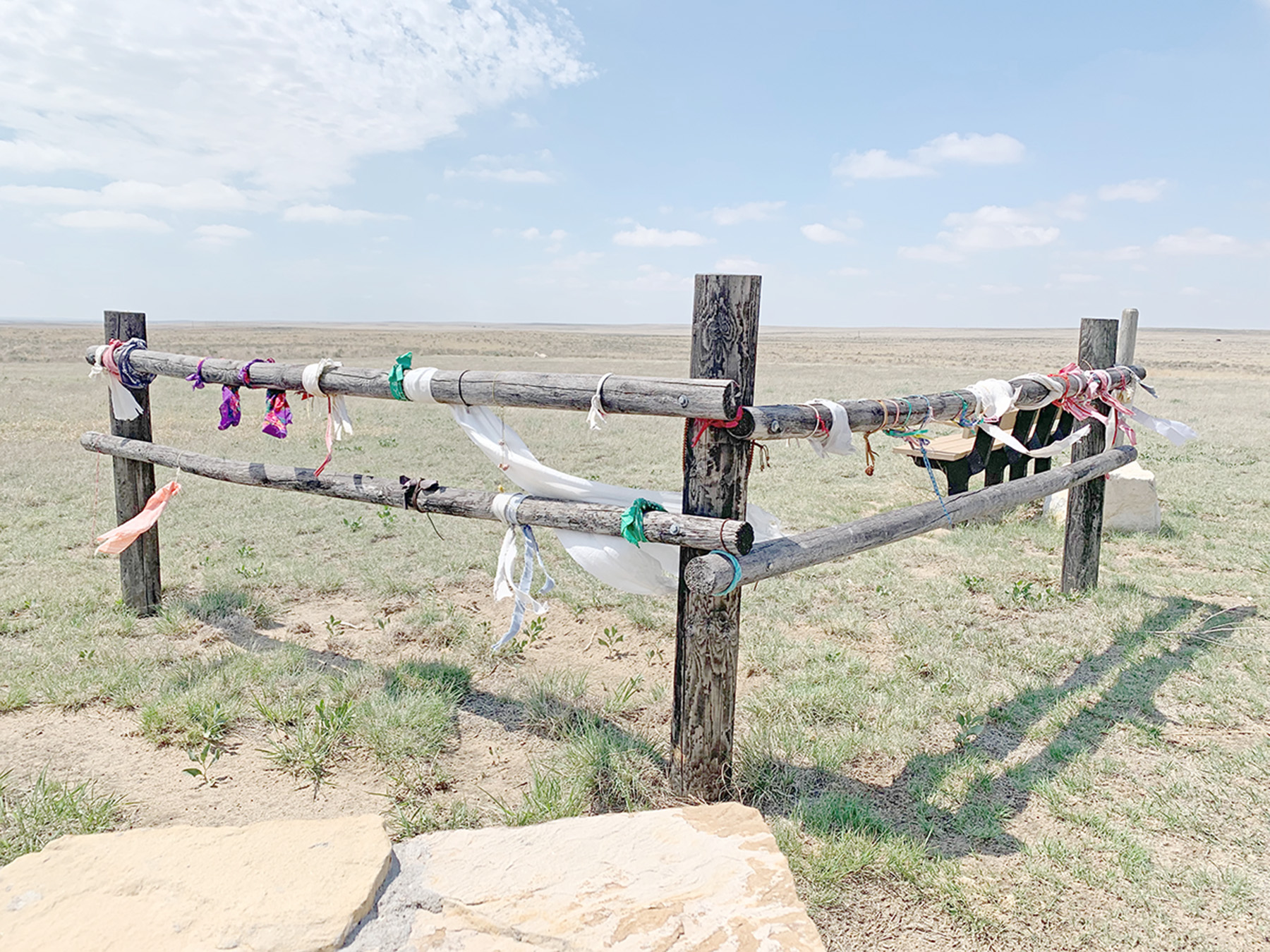 Our last pilgrimage activity took place the next day at the Sand Creek Massacre National Historic Site. In November 1864, the 3rd regiment of the Colorado Cavalry opened fire on a peaceful encampment of Cheyenne and Arapaho who were living on lands designated to them by a treaty with the federal government.
Our last pilgrimage activity took place the next day at the Sand Creek Massacre National Historic Site. In November 1864, the 3rd regiment of the Colorado Cavalry opened fire on a peaceful encampment of Cheyenne and Arapaho who were living on lands designated to them by a treaty with the federal government.
The soldiers arrived expecting armed resistance, but seeing instead a peaceful group of mostly women, children and elders, they opened fire anyway and committed other appalling acts of violence. In total, more than 230 Natives lost their lives, and many others were further embittered by the flagrant act of aggression resulting in further conflict between the tribes and the settler-colonists.
Having the opportunity to spend time with tribal leaders from the Cheyenne and Arapaho gave me a deeper insight into the lived experiences of Native Americans both during that time period and today.
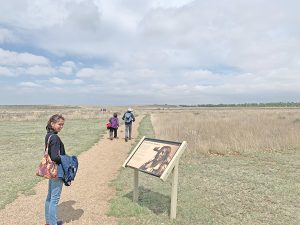
Amache Alliance volunteer Julia Shizuyo Popham reflects on the Sand Creek Massacre site.
Exploring the site before formal remarks began, I was invited inside of the tipi I was admiring by Greg Spotted Bird-Lamebull of the Cheyenne Dog Soldier Society.
Joined by a half dozen other Japanese Americans who had attended the pilgrimage, Spotted Bird-Lamebull shared stories of his tribal rituals and culture that was imparted to him by Cheyenne elders where he grew up on the reservation lands in Oklahoma. One of his grandparents was a survivor of the Sand Creek Massacre and shared his first-person recollection of those terrible events. Listening to his stories, I felt how near the Indigenous Genocide is to our own era. It made me ashamed for the failings of our education system, which to Wasano’s earlier point, largely excludes content like this.
After about 20 minutes in the tipi, we rejoined the larger group, and Cheyenne leader Otto Braided Hair shared his tribal elders’ remembrances of the Sand Creek Massacre. Like Spotted Bird-Lamebull, he, too, was a descendant of massacre survivors. Braided Hair spoke about the presence of spirits and the heavy weight that the site once held when he and other tribal leaders began visiting the site, which has gradually dissipated after many years of conducting rites and prayers.
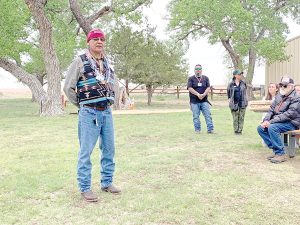
Otto Braided Hair addresses pilgrims.
Braided Hair told a story about the ribbon-cutting ceremony for their NHS designation. It was a still windless day on the prairie, but when he began praying in his language, a sudden gust of wind blew over the American flag, signaling the presence of their ancestors. We shared a laugh together before Braided Hair began his prayer. In our case, too, the wind was still and calm until the moment he began praying. Suddenly, the wind picked up and continued blowing until the cloud cover that blanketed the sky had faded past the horizon. By the time Braided Hair finished praying, the weather had changed from overcast to a bright sunny day.
As I pondered what could be described as a spiritual encounter, I began walking the trail up to the bluff hillside that overlooked the site of the massacre. Approaching the overlook, I felt a strong urge to look to my left. I later learned this was the site where repatriated remains from massacre victims had been reburied. I walked further along the trail and felt a similar impulse to look to my right, seeing the site where the massacre began. I gave a few chants of the nembutsu and paid my respects before driving three hours through rural Colorado roads back to Denver.
Ending the pilgrimage as such, this was perhaps the most significant cross-community exchange I have ever participated in. Japanese Americans and the Cheyenne leaders held space for each other’s emotions and traumatic experiences in ways that could only be possible in two communities that have experienced intergenerational trauma. I am thankful to the Amache Alliance for making this possible, and I look forward to seeing how these relationships continue to develop.
There is much we can learn from the wisdom of tribal elders, as we continue to make peace with our own prairie ghosts.



